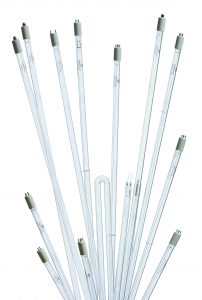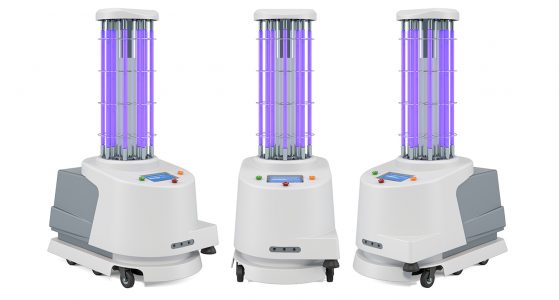UV Disinfection Robot Lamps – Proven Effective
LightSources and LightTech are leading global manufacturers of UV disinfection robot lamps and UVC germicidal lamps found in several disinfection applications worldwide. LightSources and LightTech employ a highly skilled staff of technical lighting engineers, wi th vast expertise in UV radiation and development of innovative lighting technology.
th vast expertise in UV radiation and development of innovative lighting technology.
We support OEMs worldwide, including UV robot manufacturers, with quick turn-around time, prototype development, standard and custom designed germicidal lamp products. Our patented lamp technologies are proven to outlast and outperform other providers of germicidal lamps, with long lasting effectiveness and energy savings.
We are committed to environmentally sound solutions as we balance public safety and environmental protection with effective disinfection. Our germicidal lamp products include:
- Low Pressure Amalgam Lamps
- Low Pressure Mercury Lamps
- MPUVC Disinfection Lamps
- Quartz Sleeves
- UV Germicidal Bulb
- UV Lamps
- UV Quartz Sleeves
- UV Disinfection Lamps
- UVC Ozone
- Electronic Ballasts
UVC germicidal lamps from LightSources are proven in air, water, and surface disinfection applications worldwide.
UV Disinfection Robots – How They Work
UV disinfection robots are a fairly new method of disinfecting different environments although are gaining a lot of attention particularly with disinfecting hospital rooms. UV disinfectant bot manufacturers have been designing and engineering disinfectant robots for at least a decade, although the coronavirus pandemic is accelerating production. Autonomous robots equipped with UV-C germicidal lamps are currently being produced and utilized in more than 40 countries, including Europe, Asia and the United States in hospitals and other environments.
The UVC germicidal lamps installed on these robots are the key to successful disinfection and slowing the spread of bacteria and viruses. UV disinfection bots with germicidal lamps designed to emit wavelengths at 254 nanometer (nm) emit powerful wavelengths such as 20 joules per sq. meter, per second at about a 1 meter distance. In just a few minutes, a UV disinfection robot can kill 99.99 percent of germs with greater consistency that human cleaning.
The autonomous disinfectant bots can be programmed to follow an optimized path in hospital rooms, hallways and office spaces, without human intervention and when people are not in the room as the powerful wavelengths can be harmful to humans and eyesight. The self-moving robots carry communications, vision and sensor technology while equipped with powerful 254 nm UVC lamps.
The robots move autonomously, focusing on hotspots such as touch surfaces with longer exposure times and automatically head back to their charging station. This innovative technology with touchless disinfection is helping to prevent the spread of viruses.
UV Disinfection Robots for Hospitals
There is currently a large demand for UV disinfectant robots as hospitals, schools, and offices worldwide are fighting bacteria and viruses. UV disinfection has been used for decades to disinfect air, water and surfaces, although there is a big push for more UV robots to disinfect hospital rooms amidst the global pandemic. UV disinfection bots provide touchless disinfection and allow physicians, nurses and staff to focus on other important duties such as tending to patients.
The use of UV light for room disinfection in hospitals is helping to prevent Hospital Associated Infections (HAIs) including the spread of viruses and other antibiotic-resistant MRSA infections. As reported in an article in the American Society of Mechanical Engineers, UV disinfection robots used as part of a regular cleaning cycle can kill up to 99.99 percent of pathogens on contact surfaces such as table tops, handles, and handrails while also disinfecting the air in hospital wards, significantly helping to prevent HAIs.
HAIs are a major problem in the healthcare sector with nearly 1 in 25 hospital patients in the U.S. acquiring an HAI, according to the Centers for Disease Control and Prevention. As many as 99,000 people die each year in the U.S. from an HAI, usually from a serious antibiotic-resistant bacteria which leads to sepsis and death. UV light is proven to eliminate many drug resistance diseases known as “superbugs”.
HAIs are a serious problem globally and cost thousands of lives as well as increased costs associated with extended hospital stays and readmissions. UV disinfection bots are helping to protect patients and staff in hospitals and operating rooms worldwide.
The Need for UV Disinfection Bots in Other Industries
While hospital disinfection is the driving force behind the need for UV disinfection robots, many other industries are taking notice and implementing these automated germ-killing machines. Both indoor and outdoor UV light robots are in production to disinfect and protect different environments such as:
- Schools
- College campuses
- Office buildings
- Shopping malls
- Libraries
- Industrial parks
- Airports
- Airplanes
UV disinfection bots are being designed for various applications, to provide touchless disinfection and protection to the public, hospital patients, students, and patrons. Automatic robots provide effective and efficient disinfection, often running 24 hours per day with no labor expenses.
The LightSources group is dedicated to preventing the spread of bacteria, viruses, and harmful pathogens with high-quality germicidal lamps. We are focused on continual improvement through research and development, offering first-to-market patented lamp technologies.
LAMP PRODUCT DATA:
UV Germicidal LampsLAMP Applications:
UV Germicidal ApplicationsLightSources, LightTech and our affiliated companies represent the leading, high-tech lamp designers and manufacturers in the industry. We offer patent-protected, UV germicidal lamps to a multitude of industries and applications worldwide. Contact us to learn more about our proven effective UVC germicidal lamps for UV disinfection robots.


